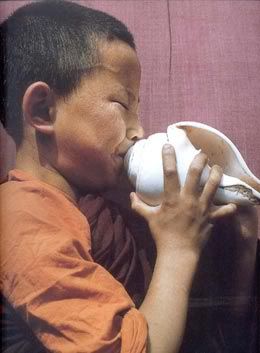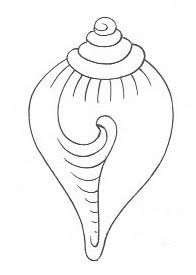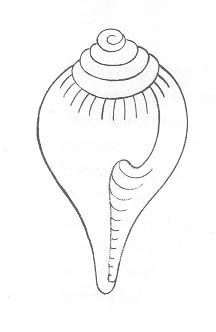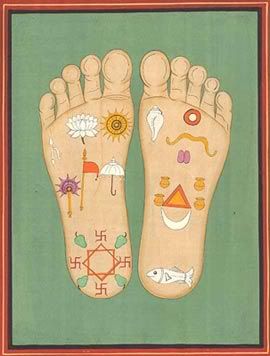The Amazing Almighty Conch Shell Part I
Posted by Tara | E-Mail The Author
I bet when you think of a conch shell you conjure images of white sandy beaches and crystal blue waters. What if I asked you to put that notion aside for a moment and take a look at the cultural and spiritual side of this fantastic shell?
The conch shell has survived as the original horn trumpet since time immemorial. Ancient Indian epics describe how each hero of mythical warfare carried a mighty white conch shell, which often bore a personal name. It is one of the main emblems of Vishnu, and his conch bears the name of Panchajanya, meaning 'having control over the five classes of beings.' Arjuna's (hero of the Mahabharata) mighty conch was known as Devadatta, whose triumphant blast brought terror to the enemy. As a proclaiming battle horn, the conch is akin to the bugle. It is an emblem of power, authority and sovereignty whose blast is believed to banish evil spirits, avert natural disasters, and scare away poisonous creatures. Today, in its greatly tamed avatar, the conch is used in Tibetan Buddhism to call together religious assemblies. During the actual practice of rituals, it is used both as a musical instrument and as a container for holy water.

Ancient Indian belief classifies the conch into male and female varieties. The thicker-shelled bulbous one is thought to be the male (purusha), and the thin-shelled slender conch to be the female (shankhini).
The fourfold caste division is also applied as follows:
a). The smooth white conch represents the Brahmin caste
b). The red conch the kshatriyas (warriors)
c). The yellow conch the vaishyas (merchants)
d). The grey conch the shudras (labourers)
Additionally, there is a fundamental classification of conch shells occurring in nature: those that turn to the left and those which turn to the right.


Shells which spiral to the right in a clockwise direction are a rarity and are considered especially sacred. The right-spiraling movement of such a conch is believed to echo the celestial motion of the sun, moon, planets and stars across the heavens. The hair whorls on Buddha's head spiral to the right, as do his fine body hairs, the long curl between his eyebrows (urna), and also the conch-like swirl of his navel.
Vajrayana Buddhism absorbed the conch as a symbol which fearlessly proclaimed the truth of the dharma. Among the eight symbols, it stands for the fame of the Buddha's teaching, which spreads in all directions like the sound of the conch trumpet.
In addition to Buddha's throat, the conch also appears as an auspicious mark on the soles, palms, limbs, breast or forehead of a divinely endowed being.

Coming soon... Part II where we will explore one town's historical, functional and sometimes comical connection with this amazing shell, plus- how to make a conch shell horn!
Don't forget to stop in to Scarborough Seashells to check out the wonderful conchs and other seashells we have for you today!
The conch shell has survived as the original horn trumpet since time immemorial. Ancient Indian epics describe how each hero of mythical warfare carried a mighty white conch shell, which often bore a personal name. It is one of the main emblems of Vishnu, and his conch bears the name of Panchajanya, meaning 'having control over the five classes of beings.' Arjuna's (hero of the Mahabharata) mighty conch was known as Devadatta, whose triumphant blast brought terror to the enemy. As a proclaiming battle horn, the conch is akin to the bugle. It is an emblem of power, authority and sovereignty whose blast is believed to banish evil spirits, avert natural disasters, and scare away poisonous creatures. Today, in its greatly tamed avatar, the conch is used in Tibetan Buddhism to call together religious assemblies. During the actual practice of rituals, it is used both as a musical instrument and as a container for holy water.

Ancient Indian belief classifies the conch into male and female varieties. The thicker-shelled bulbous one is thought to be the male (purusha), and the thin-shelled slender conch to be the female (shankhini).
The fourfold caste division is also applied as follows:
a). The smooth white conch represents the Brahmin caste
b). The red conch the kshatriyas (warriors)
c). The yellow conch the vaishyas (merchants)
d). The grey conch the shudras (labourers)
Additionally, there is a fundamental classification of conch shells occurring in nature: those that turn to the left and those which turn to the right.


Shells which spiral to the right in a clockwise direction are a rarity and are considered especially sacred. The right-spiraling movement of such a conch is believed to echo the celestial motion of the sun, moon, planets and stars across the heavens. The hair whorls on Buddha's head spiral to the right, as do his fine body hairs, the long curl between his eyebrows (urna), and also the conch-like swirl of his navel.
Vajrayana Buddhism absorbed the conch as a symbol which fearlessly proclaimed the truth of the dharma. Among the eight symbols, it stands for the fame of the Buddha's teaching, which spreads in all directions like the sound of the conch trumpet.
In addition to Buddha's throat, the conch also appears as an auspicious mark on the soles, palms, limbs, breast or forehead of a divinely endowed being.

Coming soon... Part II where we will explore one town's historical, functional and sometimes comical connection with this amazing shell, plus- how to make a conch shell horn!
Don't forget to stop in to Scarborough Seashells to check out the wonderful conchs and other seashells we have for you today!
















1 Comments:
Tara ~~~ this is such a great post ! Very, very interesting and I learned quite a bit ! ~~~ Chris
Post a Comment
<< Home